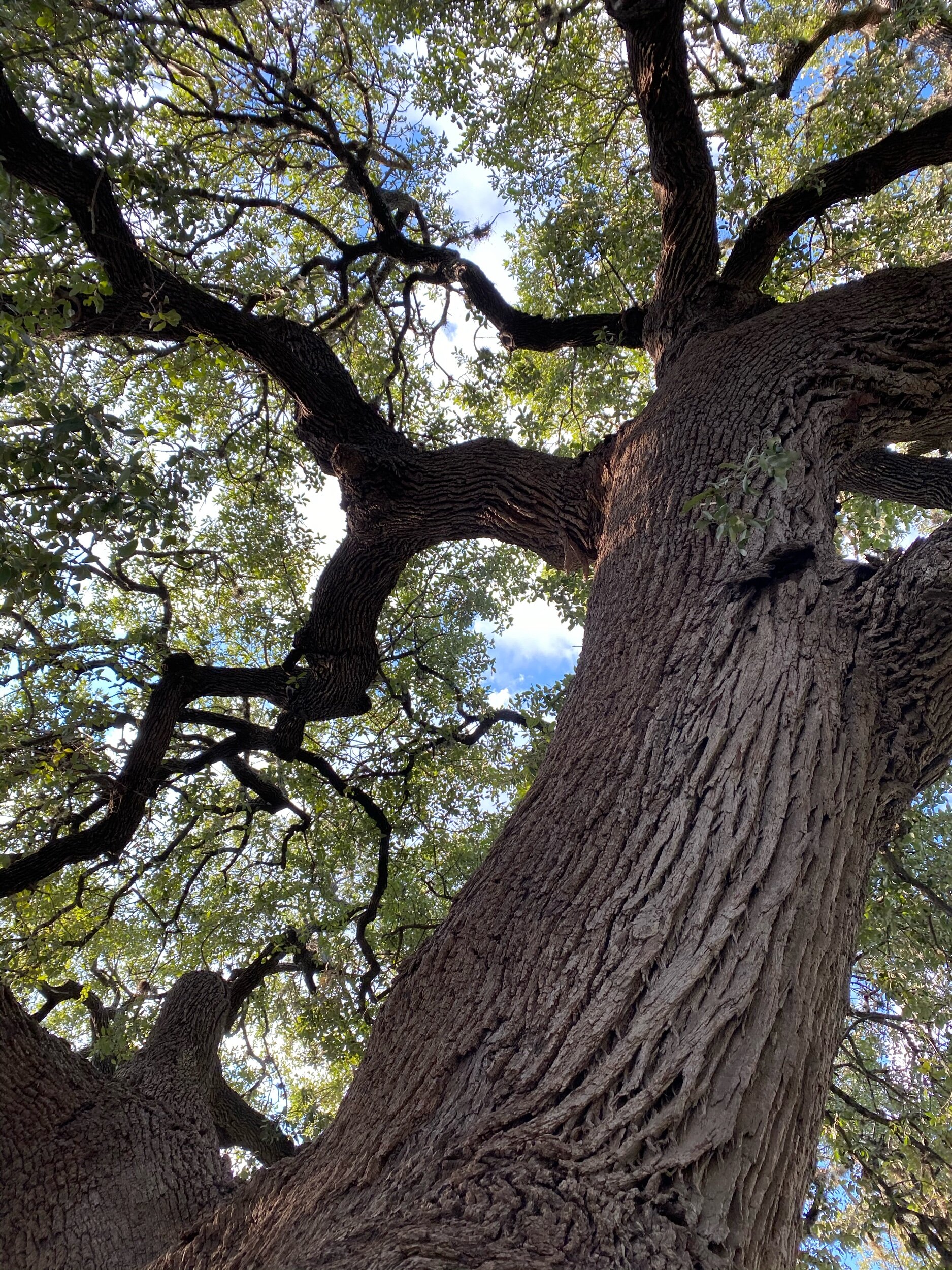
Founders Oak
Walking up to an unusually gigantic and oddly sprawling tree like this is definitely the kind of experience I hoped for when I started this project.
Photo by Johnette Alter
So, after I realized that the closest trees to my San Antonio birthday weekend destination were not exactly in the vicinity, I had to take a chance on cramming the rest of the visits into the drive home on Sunday.
Navigating I-35 towards Dallas, none of the stops were major detours, so I got my mind set on seeing them all, hoping my dear and patient friends would go along with it.
Google coordinates led us to a Landa Park on the Comal river, which is fed by natural springs, in New Braunfels, Texas.
Hopping out of the car, we spotted several big trees in the distance and started walking towards them before getting confused by another. It didn’t take long to notice a stone plaza type thing around an enormous and gratifying tree, larger than all the decoys.
Undoubtedly benefiting from the nearby river, this massive Texas Live Oak (Quercus fusiformus) leans away from the water and has nearly fallen over, but continues stretching and growing toward the sky. Large limestone brick pillars were built to support two huge trunks from further falling, but they seem to be slowly crumbling under the weight. A protective wall, added in the 80s, and iron fencing keeps most of the public from climbing on the tempting low branches.
Just wow.
Walking up to an unusually gigantic and oddly sprawling tree like this is definitely the kind of experience I hoped for when I started this project. There’s nothing like seeing a monstrously huge piece of nature to make me and my concerns feel really small. I never get enough of this feeling that instantly generates a visceral understanding of where I fit in the cosmos, which is most certainly not the center. I took a quick video of my first impression.
Because it’s leaning over, you view the structure differently than you would a classic upright specimen. Live oak branches extend out long, and these almost horizontal limbs allow you closer to the upper canopy. One of the longest branches is held up by supports, just feet above the concrete path. The book entries don’t mention this, but the on-site plaque claims that this was a seedling in 1700, putting this specimen at 320 years old!!
It says there is a possibility that native Americans might have weighted down the branches to indicate their direction of travel. Perhaps these claims are unsubstantiated?
Photo by Johnette Alter
Random detail: This metal tablet mentions Ferdinand Lindheimer, known as the “Father of Texas Botany,” stating that he arrived in Texas in 1836 to assist the revolution against Mexico. He collected botanical flora from all over central Texas. Lindheimer Muhly grass (Muhlenbergia lindheimeri) is my favorite of numerous plants named after him.
Lindheimer Muhly grass (Muhlenbergia lindheimeri)
Last measured in 2009, the trunk was 17 FEET(!), 2 inches in circumference, with a height of 50 feet and a 100 foot spread.
It has undoubtedly gained width and girth in the decade following. The monumental size and unusual form of this amazing tree makes it my second favorite of the all the famous trees I’ve seen so far. (The Houston Campsite Oak is currently in first place). If you feel an urge to visit any of the trees on my list, I highly recommend these two.
The 2015 edition of the Famous Trees of Texas mentions that the oak was named by 10-year-old Heather Stockhorst in a contest set up by the Parks & Rec, during New Braunfels 1985 sesquicentennial celebration.
My nature-loving friends were impressed and completely relaxed, taking their own photos and some of me as well. Feeling dorky and self-conscious, but knowing that seeing a human alongside this living sculpture provides visual scale, I posed in the sweltering August heat before we made like a tree and left to hunt down the the Church Oak.
































